Home >> PURE MATHS, Algebra, functions
first principles |
Introduction
To thoroughly understand the terms and symbols used in this section it is advised that you visit 'Number Set Theory ' first.
Mapping(or function)
This a 'notation' for expressing a relation between two variables(say x and y).
Individual values of these variables are called elements .
eg x1 x2 x3... y1 y2 y3...
The first set of elements (x) is called the domain .
The second set of elements ( y) is called the range .
A simple relation like y = x2 can be more accurately expressed using the following format:
![]()
The last part relates to the fact that x and y are elements of the set of real numbers R(any positive or negative number, whole or otherwise, INCLUDING zero).
One-One Mapping
Here one element of the domain is associated with one and only one element of the range.
A property of one-one functions is that a on a graph a horizontal line will only cut the graph once.
Example
![]()
Where R+ is the set of positive real numbers.
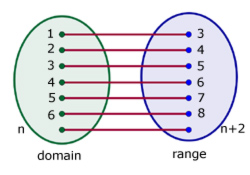
Many-One Mapping
Here more than one element of the domain can be associated with one particular element of the range.
Example
![]()
Where Z is the set of integers(positive & negative whole numbers NOT including zero).
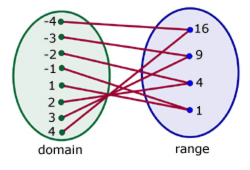
Complete Function Notation is a variation on what has been used so far.
It will be used from now on.

Inverse Function f -1
The inverse function is obtained by interchanging x and y in the function equation and then rearranging to make y the subject.
If f -1 exists then,
ff-1(x) = f-1f(x) = x
It is also a condition that the two functions be 'one to one'. That is that the domain of f is identical to the range of its inverse function f -1 .
When graphed, the function and its inverse are reflections either side of the line y = x.
Example
Find the inverse of the function(below) and graph the function and its inverse on the same axes.


Composite Functions
A composite function is formed when two functions f, g are combined.
However it must be emphasized that the order in which the composite function is determined is important.
![]()
The method for finding composite functions is simply:
1. Find g(x).
2. Find f[g(x)].
Example
For the two functions,
![]()
find the composite functions (i fg (ii g f
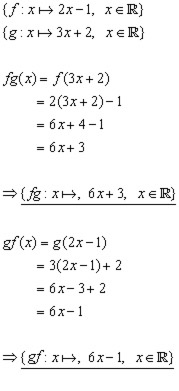
Exponential & Logarithmic Functions
Exponential functions have the general form:
![]()
where 'a' is a positive constant.
However there is a specific value of 'a' at (0,1) when the gradient is 1 .
This value, 2.718... or 'e' is called the exponential function.
![]()
The function(above) has one-one mapping.
It therefore possesses an inverse. This inverse is the logarithmic function.
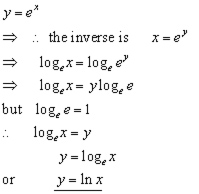
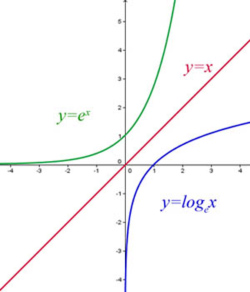
[ About ] [ FAQ ] [ Links ] [ Terms & Conditions ] [ Privacy ] [ Site Map ] [ Contact ]
